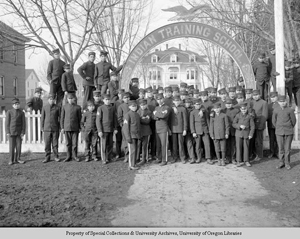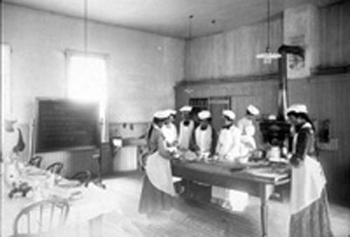Our History

History of Chemawa Indian School
Chemawa Indian School was established in the 1870s as one of two Indian schools on the East Coast when the U.S. Government authorized a school for Indigenous children in the Northwest.
 A site was chosen at Forest Grove on four acres of land rented from Pacific University. Lt. Melville Wilkinson of the U.S. Army, secretary to General O.O. Howard, led the project. The government provided $5,000 to start the school. Lt. Wilkinson, with the help of eight Puyallup Indian boys, began construction on the buildings in 1880. The initial class of students consisted of 14 boys and four girls. All the students came from the State of Washington, 17 from the Puyallup Reservation on the Puget Sound and one boy from the Nisqually Reservation. These students were taught blacksmithing, shoemaking, carpentry, wagon making, girls’ industries, and advancement in their studies.
A site was chosen at Forest Grove on four acres of land rented from Pacific University. Lt. Melville Wilkinson of the U.S. Army, secretary to General O.O. Howard, led the project. The government provided $5,000 to start the school. Lt. Wilkinson, with the help of eight Puyallup Indian boys, began construction on the buildings in 1880. The initial class of students consisted of 14 boys and four girls. All the students came from the State of Washington, 17 from the Puyallup Reservation on the Puget Sound and one boy from the Nisqually Reservation. These students were taught blacksmithing, shoemaking, carpentry, wagon making, girls’ industries, and advancement in their studies.
Before 1883, Congress was going to appropriate a more significant amount of funds for Chemawa school. Several factors led to the search for a new site for the school, including local resistance to the school, a need for more land to teach farming skills, and the destruction of the girls’ dormitory by fire in 1884.
At this point, officials looked at the temporary leased nature of the land and the poor drainage and began considering alternative sites around the Willamette Valley. Three sites were donated for the new school. Newberg offered 100 acres of heavily timbered land, 23 acres near Forest Grove with a pasture parcel of 75 acres approximately four miles away from the main site, and 171 partially cleared, sparsely timbered land in Salem served by a spur of the main railroad through the Willamette Valley. School officials chose the Salem site since it was close to the state capital and had the most acreage.
 In 1885, the school moved to a site five miles north of Salem and began construction. The first buildings were made of wood and later razed for more permanent brick structures. On June 1, 1885, the Chemawa Indian School was opened, with approximately half of the students moving to the new location while half stayed behind in Forest Grove. On October 1, 1885, Mr. John Lee became superintendent of Chemawa Indian School (then known as Salem Indian Training School). After a winter of separation and after staff and students finished construction on three new buildings on the campus, he withdrew the remaining students from Forest Grove. He reunited them all on the Salem campus.
In 1885, the school moved to a site five miles north of Salem and began construction. The first buildings were made of wood and later razed for more permanent brick structures. On June 1, 1885, the Chemawa Indian School was opened, with approximately half of the students moving to the new location while half stayed behind in Forest Grove. On October 1, 1885, Mr. John Lee became superintendent of Chemawa Indian School (then known as Salem Indian Training School). After a winter of separation and after staff and students finished construction on three new buildings on the campus, he withdrew the remaining students from Forest Grove. He reunited them all on the Salem campus.
The first graduating class completed the sixth grade in 1886. Subsequently, courses were added through the 10th grade. In 1900, Chemawa had 453 students, the largest of its kind in Oregon, with a federal budget of $57,182.62. At that time, it emphasized vocational training.
The 1913 report lists farming as one of the major areas of training. Dairying, stock raising, and other farm methods provided food that the students preserved for later use. A school library provided reading material, and students could participate in basketball, baseball, and football. There were 690 students enrolled, with 175 Alaskan children.
By 1922, there were 70 buildings on the 40-acre campus. Most of the buildings were wood-frame, but some of the newer ones were brick construction. The school's land area had grown to 426 acres. Some of the land had been purchased by Indian students, who had given it to the school as a token of their gratitude for the money earned by picking hops.
1926 saw the peak enrollment at Chemawa; almost 1,000 students were enrolled. The 11th and 12th grades were added to the curriculum, and all grades below the 6th were dropped. In 1927, Chemawa became a fully accredited high school.
In an economic move, the school was threatened with closure in the early 1930s, but due to the efforts of interested journalists and Oregon's Congressional delegation, it remained open with 300 students. The 1940s and 1950s brought other changes, including a unique program for Navajo students and changes in policy to bring back Northwest students, particularly those from Alaska. In the late 1970s, Chemawa moved to a new campus on adjacent land, where most of the original brick buildings had been destroyed.
Chemawa Indian School is over 125 years old, making it the oldest, continuously operated boarding school for Native American students in the United States. While its mission has changed over the years, its most important goal has always been educating Native American students and preparing them for success in the future. Recently, the school has embarked on a more rigorous mission to help students reach the highest goals and achieve the most they can in their life after high school. This is complemented by the help of the Indian Health Services clinic located right on campus, the AVID program, which seeks to help underserved students with access to higher-level classes and college entrance requirements, and the Chemawa Partnership Program with Willamette University, which brings enthusiastic college students to campus to interact with Chemawa students.



